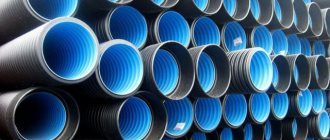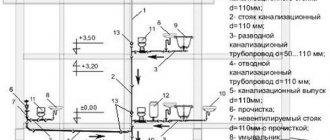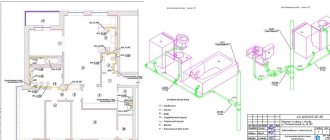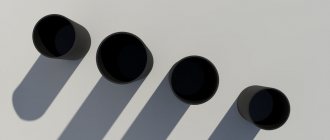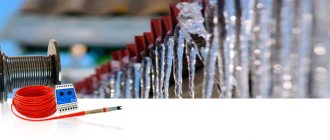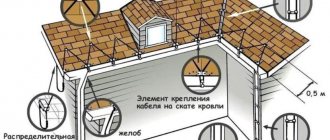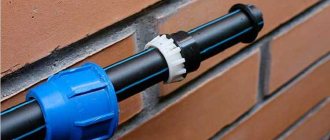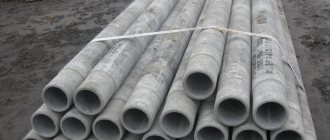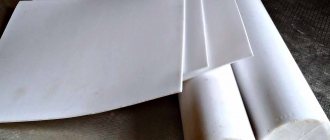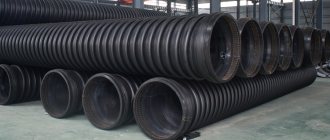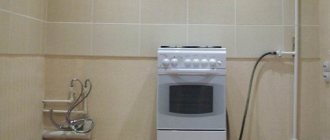Greetings, comrades! Today's topic is Korsis sewer pipes. We have to get acquainted with their features, assortment and find out how the connections of these products with each other and with the fittings are mounted. Let's get started.
The use of Korsis sewer pipes for the installation of sewer collectors.
General information
1.1. History of sewer pipes
Historically, sewers were open channels and structures made of stone, brick or wood, and pipes made of various metals were also used. At the end of the 19th century, sewer systems made of reinforced concrete pipes appeared. In the mid-20th century, a new solution was invented - polymer pipes, which made it possible to quickly build durable and reliable pipelines. In a short period of time, pipes made from polyvinyl chloride (PVC), polyethylene, polypropylene and their various derivatives were developed and used. These pipes are lightweight and easy to install and, moreover, are affordable. During the construction and operation of sewer networks, shortcomings of some materials were also noticed, for example, PVC did not always meet the necessary operational parameters, primarily due to increased fragility and low frost resistance, while polyethylene grades were constantly being improved.
At the moment, polyethylene has an optimal combination of physical and chemical properties: high chemical resistance, frost resistance, viscosity, durability, the ability to self-compensate for internal stresses and many others, which will be discussed below. In recent years, progress has been directed towards the creation of lighter types of pipes with high ring stiffness and a better stiffness/material consumption ratio compared to other materials.
Research was carried out on a wide variety of types of pipe wall profiles, which led to the creation, in particular, of CORSIS pipes.
Double-layer polyethylene pipes KORSIS are characterized by excellent resistance to the aggressive effects of wastewater and loads arising during installation and operation, ease of installation, durability, and excellent quality/price ratio.
1.2. Requirements for sewer pipelines.
Economic feasibility of application
Requirements usually applied to any sewer pipelines:
- good long-term hydraulic characteristics;
- resistance to external loads;
- long-term tightness of connections;
- optimal corrosion and chemical resistance;
- high resistance to abrasion;
- low overgrowth with various types of sediments;
- simple and quick installation;
- competitive price in comparison with other materials.
The material and type of pipe must comply with the conditions stipulated by the project. First of all, this relates to hydraulic characteristics, outer diameter and the value of the roughness coefficient. Resistance to chemical attack and abrasion must be assessed taking into account the properties of the wastewater. The tightness of the pipe system must be two-way: many of the problems found in existing sewers that cause damage to treatment plants are caused by groundwater infiltration at the connections. Lack of sealing is mainly due to improper installation of the pipe, although it may also be due to improper joint design or the type of seal used.
When analyzing the economic feasibility of using polyethylene pipes, it should be noted that it is much more important to make comparative estimates of the costs of laying a pipeline, but to consider the sewer pipeline as a whole, including in these estimates the future costs of maintenance and repair, as well as service life, preferably not less than 50 years old.
When designing sewer systems, primary considerations are typically given to issues of final cost (which refers to the total cost of material, installation and operation) and durability if properly maintained.
On this basis, the project developer, customer, contractor and maintenance service must optimize the project as a whole, consisting of: analysis of detailed construction plans, optimal choice of material, precise determination of the most economical and suitable installation methods, technically and economically efficient installation, and finally the correct mode operation.
The KORSIS polyethylene pipe best meets all the specified requirements.
Areas of use
All Korsis are designed for transporting wastewater - domestic, industrial (except high-temperature) and storm water. However, for some lines the manufacturer mentions additional functionality:
- Korsis and Pro can be used to restore worn out or partially destroyed pipelines: they are pulled through the old sewer line and take over its functions. In this case, the throughput practically does not suffer: the smaller cross-section is compensated by smooth walls and, accordingly, minimal hydraulic resistance of the new pipe;
- They can also be used to repair culverts under roads and to make plastic wells;
- The Protect and Plus lines are used for the construction of protective cases for underground pipelines;
- Spiroline is even used for the construction of sewage pumping stations (sewage pumping stations), pontoons and reservoirs for technical fluids and water.
The photo shows a pump station with a body made of corrugated pipe.
Nomenclature of KORSIS pipes
2.1. Ring stiffness classes
KORSIS pipes are produced in various classes of ring stiffness.
The ring stiffness class (SN) is a value rounded to the nearest lowest value of the nominal ring stiffness from the series 2, 4, 6, 8, etc.
The value of the ring stiffness (S) is determined using empirical formulas.
Read more: Ring stiffness classes
2.2. KORSIS pipe design
The design of the pipe is shown in Figure 3. The dimensions of the pipes, including those for various classes of nominal ring stiffness SN, are given in Table 1.
Based on the practice of production and application of KORSIS pipes, the following classes of nominal ring stiffness are currently produced: SN 6 and SN 8. KORSIS pipes of different classes of ring stiffness differ only in the thickness of the outer corrugated wall. The equipment used ensures a constant value of the internal and external diameters, which allows hydraulic calculations to be made without taking into account different classes of ring stiffness and ensures a stable connection using standard couplings for pipes of all classes of rigidity.
For KORSIS pipes, the minimum ring stiffness value guaranteed by the manufacturer is used for strength calculations.
Pipes are manufactured in the following types:
- pipe without socket;
- a pipe with a welded socket for connection with a rubber sealing ring.
Pipes are manufactured in straight sections of 6 and 12 m in length, the maximum deviation of the length from the nominal length is no more than 1%. It is possible, by agreement with the consumer, to manufacture pipes of other lengths and other maximum deviations.
2.3. Geometric characteristics of KORSIS pipes
Table 1. Geometric characteristics of the KORSIS pipe, mm
| Nom. pipeline size/internal diameter (DN/OD)/di | Average outer diameter dem | Inner diameter di | Corrugation height ec | Corrugation wall thickness e3, not less, for nominal ring stiffness | Internal wall thickness layer e5, no less | Wall thickness e4 | Corrugation pitch t | Corrugation protrusion width l | ||||
| Nom. outer diameter dn | Prev.off | Nominal | Prev.off | SN6 | SN8 | SN6 | SN8 | |||||
| 110/91 | 110 | ±0,6 | 91 | 8,7 | ±0,8 | 0,45 | 0,5 | 0,55 | 0,8 | 1,0 | 12,6 | 8,6 |
| 160/139 | 160 | ±0,8 | 139 | 10 | ±1,0 | 0,6 | 0,7 | 0,7 | 0,8 | 1,0 | 12,6 | 9,0 |
| 200/176 | 200 | ±1,0 | 176 | 13,0 | ±1,0 | 0,6 | 0,7 | 1,1 | 1,4 | 16,5 | 12 | |
| 250/216 | 250 | ±1,2 | 216 | 15,0 | ±1,5 | 0,7 | 0,8 | 1,4 | 1,7 | 37 | 23 | |
| 315/271 | 315 | ±1,4 | 271 | 21,0 | ±1,5 | 0,9 | 1,2 | 1,6 | 1,9 | 42 | 27 | |
| 400/343 | 400 | ±1,8 | 343 | 26,0 | ±1,5 | 1,2 | 1,5 | 2,0 | 2,3 | 49 | 30 | |
| 500/427 | 500 | ±2,0 | 427 | 33,0 | ±1,5 | 1,4 | 1,6 | 2,8 | 2,8 | 58 | 38 | |
| 630/535 | 630 | ±2,4 | 535 | 45,0 | ±2,0 | 1,6 | 1,6 | 3,3 | 3,3 | 75 | 47 | |
| 800/678 | 800 | +2,0/-4,0 | 678 | 55,0 | ±2,0 | 1,7 | 2,3 | 4,1 | 4,1 | 89 | 56 | |
| 1000/851 | 1000 | +2,0/-4,8 | 851 | 71,0 | ±2,0 | 2,0 | 2,4 | 5,0 | 5,0 | 98 | 60 | |
| 1200/1030 | 1200 | +2,8/-4,0 | 1030 | 79,0 | ±2,0 | 2,2 | 2,6 | 5,0 | 5,0 | 110 | 80 | |
Table 2. Estimated mass of KORSIS pipes
| Nominal size | Estimated weight of 1 m of pipes, kg | |
| SN6 | SN8 | |
| 110/91 | 0,87 | 0,95 |
| 160/139 | 1,49 | 1,7 |
| 200/176 | 2,03 | 2,3 |
| 250/216 | 3,20 | 3,5 |
| 315/271 | 5,05 | 5,4 |
| 400/343 | 7,05 | 8,3 |
| 500/427 | 10,90 | 12,6 |
| 630/535 | 16,15 | 17,7 |
| 800/687 | 28,75 | 32,5 |
| 1000/851 | 42,25 | 46,5 |
| 1200/1030 | 60,25 | 64,5 |
2.4. Control requirements for KORSIS pipes
KORSIS pipes are produced using the technology and equipment of POLIECO (Italy), a leading European manufacturer of corrugated pipes and a developer of equipment for their production with more than 15 years of experience. Products and equipment undergo annual certification.
KORSIS pipes are manufactured according to TU 2248–001–73011750–2005, which are developed in accordance with the requirements of the European standard EN 13476, type B.
The polyethylene used for the manufacture of KORSIS pipes meets the requirements of Table 3 (according to TU 2248–001–73011750–2005).
Table 3. Material requirements for the manufacture of KORSIS pipes
| Indicator name | Meaning | |
| 1 | Resistance at constant internal pressure at 80 °C, h, not less | At an initial stress in the pipe wall of 3.9 MPa 165 |
| 2 | Resistance at constant internal pressure at 80 °C, h, not less | At an initial stress in the pipe wall of 2.8 MPa 1000 |
| 3 | Melt flow rate at 190 °C and 5 kgf, g/10 min, no more | 1,6 |
| 4 | Thermal stability at 200 °C, min, not less | 20 |
| 5 | Density, kg/m3, not less | 950 |
| 6 | Mass fraction of carbon black (soot), % mass | 2,0–2,5 |
| Note – tests for indicators 1 and 2 are carried out on pipe samples with a diameter of 32–63 mm with SDR 11 according to GOST 18599. | ||
Carbon black is a highly effective light stabilizer and protects the outer layer of pipes from ultraviolet radiation during storage. Chemical light stabilizers are also introduced into the white inner layer of polyethylene.
To check the quality compliance, each batch of pipes undergoes acceptance and periodic tests specified in Table 4. Sampling (in the form of pipe sections) is carried out by random sampling during the production process.
Table 4. Control requirements for KORSIS pipes
| Indicator name | Meaning | |
| 1. | Appearance | Grooves, bubbles, cracks, cavities, foreign inclusions visible without magnifying instruments. The ends of the pipes should be cut off in the middle of the corrugation cavity. The color of the outer layer is black, the inner layer is white. The appearance of the surface of the pipes and ends must correspond to the control sample. |
| 2. | Ring stiffness, kN/m2 | SN 6, SN 8 |
| 3. | Ring flexibility at 30% deformation de | Absence on the test sample: — cracking of the inner or outer layer; - wall delamination, — destruction of the sample, — fractures in the cross section of the sample |
| 4. | Creep coefficient, no more | 4 when extrapolated to 2 years |
| 5. | Tightness of connection with O-ring 5.1. with socket deformation 5%, pipe 10% 5.2. with angular displacement of pipe connection: de315 – 2.0° 315 630 | 1) At a water pressure of 0.05 bar for 15 minutes. No water leaks 2) At a water pressure of 0.5 bar for 15 minutes. No water leaks 3) At negative air pressure – 30 kPa (– 0.3 bar). Pressure drop to 1) At a water pressure of 0.05 bar for 15 minutes. No water leaks 2) At a water pressure of 0.5 bar for 15 minutes. No water leaks 3) At negative air pressure – 30 kPa (– 0.3 bar). Pressure drop to |
| 6. | Resistance to heating at temperatures (110±2) °C | No delaminations, cracks, bubbles. According to GOST 27077 and clause 4.8 of TU 2248-001-73011750-2005 |
2.5. Marking of pipes KORSIS
The marking is applied to the surface of the pipe along the corrugation using color printing at a distance of no more than 3.0 m along the pipe.
The marking is also applied in the form of a label, protected by a polymer film, glued to the inner surface of the pipe.
It is allowed to apply markings along the axis of the pipe.
The marking includes the name of the manufacturer, trademark, symbol of the pipe without the word “pipe”, date of manufacture (day, month, year). It is allowed to include other information in the marking, for example, batch number, line, etc. Transport marking - in accordance with GOST 14192.
2.6. Symbols for KORSIS pipes
The symbol consists of the word “pipe”, the trade name “Korsis”, the nominal outer diameter DN/OD, the presence of a socket P, the nominal ring stiffness SN, and the designation of technical conditions.
Examples of symbols:
Korsis pipe with nominal outer diameter DN/OD 315 mm, nominal ring stiffness SN 6:
Pipe KORSIS DN/OD 315 SN 6 TU 2248-001-73011750-2005
Pipe "Corsis" with a nominal outer diameter DN/OD 1000 mm, nominal ring stiffness SN 8 with a socket:
Pipe KORSIS DN/OD 1000 R SN 8 TU 2248-001-73011750-2005.
Installation
How do Korsis connect to each other and to the fasonina?
Here is a description of some installation methods.
| Image | Description |
| Connection with a slip coupling . Tightness is ensured by an o-ring installed in the cavity between the corrugations. The manufacturer's instructions recommend installing the ring in the first cavity with a cross-section of 250 mm or more, and in the second with a cross-section of 200 mm or less. | |
| Socket connection . The seal is the same as in the previous case. | |
| Electrodiffusion welding . The smooth end is welded to the socket with a heating coil built into it. To ensure a tight fit of the surfaces, the pipe expands from the inside, and the socket contracts. This method is used to connect products from the Corsis Plus line. |
To simplify the assembly of pipe connections with rubber seals with your own hands, the manufacturer recommends using lubricant from its own product range. Lubricant is applied directly to the O-ring.
Properties of KORSIS pipes
3.1. Material Specifications
Table 5. Main technical characteristics of polyethylene
| Indicator name | Dimension | Meaning |
| Melt index | g/10 min | 0,4-0,7 |
| Tensile yield strength | MPa | 20-25 |
| Relates. elongation at break | % | > 600 |
| Brittle point | °C | |
| Flexural modulus | MPa | 1000-1200 |
| Impact strength | kJ/m2 | No gap |
| Thermal expansion coefficient | mm/m°С | 0,17 |
3.2. Chemical resistance
The high resistance of polyethylene to aggressive chemicals is well known. Polyethylene is resistant to the vast majority of chemical reagents, including at elevated temperatures of the transported medium, in contrast to traditional materials that corrode and age under the influence of aggressive environments.
Polyethylene pipes are resistant to strong alkalis, strong and weak mineral acids, salt solutions, aliphatic hydrocarbons and mineral oils. Chemical resistance depends on the type of chemicals, their combination, concentration, temperature and duration of exposure.
Information on this issue can be found in document ISO/TR10358 (Table 6) and in a number of catalogs published by manufacturers and consumers of polyethylene, as well as in CH 550-82.
KORSIS pipes also have low vapor and gas permeability.
Table 6. Chemical resistance of polyethylene used for the manufacture of KORSIS pipes
Table 6. Chemical resistance of polyethylene used for the manufacture of KORSIS pipes Continued 1
Table 6. Chemical resistance of polyethylene used for the manufacture of KORSIS pipes Continued 2
3.3. Resistance to water-abrasive wear
During operation, pipes are subject to intense wear by solid abrasive particles contained in water and other media transported through pipes. Therefore, the issue of pipe wear resistance is important and requires a clear understanding and accurate assessment.
When assessing wear resistance, three types of wear are distinguished:
- abrasive;
- fatigue (on smooth steel or mesh);
- waterjet.
In Russia, there is only one standard for abrasive wear - GOST 11012, which evaluates wear resistance under the most severe conditions of abrasive wear.
Since wear resistance indicators vary greatly with changing operating conditions, several test methods have been developed and standardized to simulate operating conditions. These standards are presented in the group “Ensuring wear resistance of products”.
The international standard - ISO 9352-1995 uses a method for determining wear resistance using abrasive discs.
The main type of wear for non-pressure sewage systems transporting suspensions is hydroabrasive wear. In sewer systems, abrasion occurs mainly in the lower segment of the pipe. Abrasion occurs due to friction, rolling, or shearing of the pipe material by moving abrasive particles.
The main method for assessing water-abrasive wear of pipes is the so-called Darmstadt procedure, which proposes the following test bench design, in which pipe sections 1000 mm long were filled with an aqueous suspension with abrasive particles and rocked with a certain frequency, causing wear as the particles moved along the wall.
This test method was used by such well-known foreign companies as: Borealis, Uponor, Wavin, and the South German Center for Artificial Materials.
The test results using this method were published in the reference materials “Construction of pipeline systems using plastic pipes” (NordiskaPlastrorGruppen - Nordic Association of Plastic Pipe Manufacturers) where they showed that: “after 130,000 cycles (swinging of pipe samples) with the movement of 390 tons of sand, which can be considered equivalent to transporting sand in a conventional
sewer pipe for approximately 195 years, the actual wear of the wall of polyethylene pipes was 0.1 mm. Thus, it is confirmed that wear can indeed be neglected even for pipes with relatively small wall thicknesses.”
Pipe materials such as fiberglass, ceramics, and concrete found themselves in a worse position with this method. The wear of pipe walls made of these materials turned out to be an order of magnitude higher (Figure 10). Additionally, it should be noted that water-abrasive wear strongly depends on the flow regime of the suspensions. It is minimal at high flow rates, which does not allow suspension particles to settle on the bottom of the pipe. With a decrease in speed and an increase in the volume of particles falling to the bottom of the pipe, wear increases and becomes maximum when suspension particles begin to slowly move along the bottom of the pipe.
The high wear resistance of polyethylene pipes has been confirmed not only by experiments, but also by the successful operation of pipelines for decades all over the world.
3.4. Thermal expansion of KORSIS pipes
To calculate the magnitude of thermal linear expansion ΔL, the formula is usually used:
(3.4.1)
where: α – coefficient of linear thermal expansion, 1/°С (for polyethylene α = 2*10-4),
L is the linear size of the body (in our case, the length of the pipe),
ΔT – temperature change.
A ten-meter section of polyethylene pipe will lengthen by ΔL = α*ΔT when the temperature increases by 20°C. L = 2 * 0.0001 * 20 * 10000 = 40 mm.
When the temperature changes, the support reaction force N acts on the fixed ends of the pipe, which prevents its elongation.
Compressive stresses arise in the pipe wall, the magnitude of which is determined by the equation:
(3.4.2)
Where:
E – modulus of elasticity of the polyethylene pipe material, equal to 800*106 N/m2 at 20°C.
The force with which the pipe acts on the supports is determined by the equation:
(3.4.3)
where: F is the area of the pipe wall in its cross section.
When carrying out calculations, it is clear that the stresses arising in the walls of the pipe are 6-10 times less than the yield strength of polyethylene. Another feature of polyethylene is its tendency to relax: at a fixed deformation, internal stresses are halved within an hour. This phenomenon is commonly called “self-compensation”.
It should also be taken into account that when laying underground, the pipe is clamped by soil, which prevents its elongation. As a rule, when using KORSIS corrugated pipes, the soil completely compensates for the linear expansion of the pipe. The empirical formula given in SP 40-102-2000, clause 6.7.1 shows the degree of reduction in pipe elongation in the ground. It is clear from the formula that the main factors in this case are: the depth of the pipe, the degree of compaction of the pipe sinuses, and the length of the pipeline.
When expanding, the KORSIS pipe overcomes not only the friction force, but also the resistance of the soil in the sinuses of the profile (the soil is subject to crushing and shearing). Therefore, profiled pipelines, to a lesser extent than smooth ones, experience stress at the ends of sections during linear thermal expansion. It should also be noted that a profiled pipe, as a rule, has a lower linear expansion rate compared to a conventional polyethylene pressure pipe.
In order to check the behavior of the profiled pipe during thermal expansion, it was subjected to several laboratory tests. The samples were kept at temperatures from -10°C to +70°C, and their lengths were compared with those obtained at ambient temperature on a conventional polyethylene pressure pipe of the same length, the same diameter and of the same material. The thermal expansion index of a sample made from a profiled pipe was 50% lower than that of a conventional pressure polyethylene pipe. The actual coefficient of linear expansion for the KORSIS pipe is equal to
(3.4.4)
Tests were also carried out to check the temperature change of the outer diameter. In the temperature range from –10°С to +70°С, both longitudinal and transverse changes in the geometric dimensions of the KORSIS pipe did not exceed ±0.5%. Thus, the KORSIS pipe system is significantly less affected by changes in temperature conditions than a conventional polyethylene pressure pipe.
Similar products
Does Corsis have analogues? Of course, a direct competitor on the Russian market is produced by Pipelife under the Pragma brand.
Unlike Polyplastic products, Pragma sewer pipes are made only from polypropylene. This choice of material ensures high heat resistance and mechanical strength of the pipes.
Another analogue of Korsis is produced under the Pestan brand. These are two-layer polypropylene pipes with dimensions of 150-1000 mm. Country of origin: Serbia.
Density and ability to withstand maximum loads
The technical characteristics and dimensions of Korsis pipes are one of the main factors that you should pay attention to when purchasing such products. Among other features, one should take into account the density, which is 900 kg/m3. If the operation of the pipe is planned under extreme conditions, then it is also important to take into account the ability of the products to endure maximum loads. For example, if a liquid with a temperature of up to 200 ° C is passed through a pipe, it can last up to 800 minutes. The maximum operating time is 140 hours if the liquid is heated to 80 °C and the pressure is 4.2 Pa. When the pressure drops to 2.5 and the heat increases to 95 °C, the pipe will work properly for 1000 hours.
Additional characteristics: resistance to various influences
Before purchasing a pipe, you may want to know about its additional features. For example, the PRO series is manufactured using imported components such as a high-modulus block copolymer. High-quality raw materials allow us to achieve high strength of the finished product and its reliability.
When choosing pipes, you should know that they are intended for the following systems:
- removal of industrial wastewater;
- domestic drainage;
- storm sewer.
When purchasing double-layer profiled pipes, you should know about their advantages, such as:
- ability to endure high loads;
- resistance to mechanical stress;
- resistance to chemical components;
- ability to withstand a wide range of operating temperatures.
Since the pipes have a high level of rigidity, they can be laid even at depths of up to 15 m. They are resistant to environmental influences, such as soil. The technical characteristics of Korsis pipes make them easy to transport and install. This process is facilitated by a wide selection of fittings that allow you to connect pipes to each other and connect them to structures.
Since the products can be exposed to high operating temperatures, they can be used to drain not only cold, but also hot liquid. It is especially important to pay attention to one point where a drawback is hidden - the operating temperature ranges from -20 to + 95 ° C, which excludes the possibility of open installation on the street.
Price
Below are the average prices for Korsis pipes; the current cost and other information can be found on the manufacturer’s official website: www.polyplastic.ru.
| Diameter | Price (rub) 1 m.p. | With bell | ||
| outer | interior | 1 p/m of pipes 6 m long | 1 p/m of pipes 12 m long | |
| 110 | 94 | 221 | ||
| 160 | 136 | 383 | ||
| 200 | 171 | 619 | ||
| 250 | 213 | 986 | 1032 | 1009 |
| 315 | 271 | 1563 | 1633 | 1598 |
| 400 | 343 | 2394 | 2525 | 2460 |
| 500 | 427 | 3615 | 3861 | 2738 |
| 650 | 535 | 5035 | 5490 | 5263 |
| 800 | 687 | 9381 | 9876 | 9629 |
| 1000 | 851 | 13350 | 14230 | 13792 |
| 1200 | 1030 | 18415 | 19905 | 19159 |
Peculiarities
A distinctive feature of these products is the color black on the outside and white or blue on the inside. As mentioned above, they consist of two layers. The corrugated, double-arch corrugated outer surface provides the pipe with protection during deformation, and the smooth inner layer does not allow debris to linger on the walls.
Scope of application:
- sewer systems;
- restoration of throughput pipes in the roadbed;
- drainage of storm and melt water;
- drainage systems.
Video: Korsis pipe
